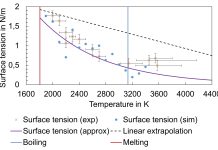Open Access Government produces compelling and informative news, publications, eBooks, and academic research articles for the public and private sector looking at health, diseases & conditions, workplace, research & innovation, digital transformation, government policy, environment, agriculture, energy, transport and more.
Home 2025
Archives
Vaporization impacts surface tension
In this article, Prof Dr-Ing. Jörg Volpp from University West, Trollhättan in Sweden, explores how surface tension in pure metals behaves at high temperatures, particularly in the boiling range.
Bridging big science and industry quality control for laser manufacturing processes
Discover how researchers are making the PETRA III Swedish Materials Science beamline’s X-rays accessible for tracking the evolution of material properties during laser processing.
Enhanced remanufacturing – A sustainable and resilient alternative to traditional manufacturing
Manufacturing infrastructure can be very difficult to change. Sustainability issues concern both energy and materials. Here, we focus on remanufacturing.
Laser light absorption on molten metal
Light absorption at high temperatures is highly impacted by interband absorption in addition to intraband absorption.
University West – Division of Mechanical Engineering: Additive Manufacturing research
University West (Högskolan Väst) aims to contribute to innovation, social development, and a sustainable world through its education and research, particularly in Additive Manufacturing/
Material resources for the green transition
We can see that things need to change. Using fossil fuels for energy is not a viable long-term solution for future societies. Oil and gas resources are limited, and emissions continue to alter the global climate, making life on Earth increasingly uncomfortable. Efforts have been made to guide societies towards alternative pathways for harnessing energy from diverse sources and reducing greenhouse gas emissions. Some initiatives appear to be quite effective. For instance, steelmakers are progressing in their transition from fossil fuels to hydrogen as their energy source. This switch could result in significant emission reductions, provided the hydrogen is produced using electricity generated from renewable sources. Furthermore, numerous countries have expressed their commitment to achieving a zero-emission industry and society. The EU has set forth related goals to meet specific emission targets over the coming years and decades.
Does surface tension above boiling temperature still exist?
It remains unclear whether boiling metal surfaces can still show surface tension, says Prof Dr-Ing. Jörg Volpp, Associate Professor at University West, Trollhättan in Sweden.
Understanding high-temperature material properties
Prof Dr-Ing. Jörg Volpp, Associate Professor from University West, Trollhättan, Sweden, states that understanding metal surface tension at high temperatures will increase process understanding to benefit European Union metal processing and manufacturing industries.









